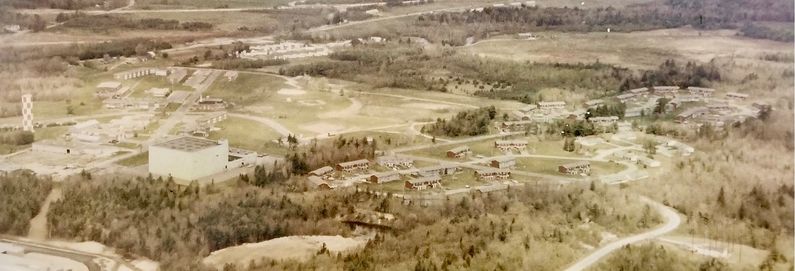Topsham SAGE Direction Center DC-05
|
HistoryEstablished in 1958 and became operational on 1 Mar 1958 as Topsham SAGE Direction Center DC-05.  Direction center equipment included the duplex FSQ-7 computer system and associated communication equipment. The FSQ-7 computer system assembled digitized inputs from USAF Radar Sites to provide tracking and identification of all aircraft within their sector of responsibility. The digitized radar inputs came from USAF Radar Sites, airborne radar pickets, Texas Towers, Gap Filler Radar Sites and other radar sources. The total picture of aircraft in the sector was assembled and any unknown aircraft were checked out and hostile aircraft were engaged by USAF fighter aircraft, Bomarc missiles or NIKE missiles. The primary defense was against the Soviet threat of a mass nuclear bomber attack on the US. The system evolved before the advent of ICBMs and provided no missile defense against them. The computer technology was first generation vacuum tube equipment and required significant power and air conditioning. The physical plant of the direction center was enclosed in a large multi-story concrete blockhouse that housed the duplex FSQ-7 computer, communications equipment, a powerhouse, air conditioning systems and operational areas. The operational areas included radar mapping, air surveillance, identification, communications and weapons direction. The enormous cost of the radar sites, direction centers, personnel, and training caused an immediate reevaluation and almost as quickly as they were built some facilities were closed. The first mass closures began in the 1960s when many radar sites and virtually all the gap filler sites were closed. The first round of direction center closures came in 1963 when six were closed, a second round in 1966 and a third in 1969 that closed a total of 17 out of 23. The remaining six direction centers became SAGE Regional Control Centers (RCCs) still using the massive FSQ-7 vacuum tube computers. As the direction centers and radar sites closed the remaining sites were realigned into ever-increasing sectors. A new Joint Surveillance System (JSS) evolved as a partnership between the Air Force and the FAA to provide nationwide radar coverage. When completed in 1983 it consisted of only forty-six radar sites feeding into four new Region Operation Control Centers (ROCCs) with FYQ-93 computer systems. With the activation of the four U.S. ROCCs and the two Canadian ROCCs, the last seven of the SAGE direction centers were deactivated and this signaled the end of the SAGE system. Of the remaining forty-six radar sites, thirty-one had FAA-operated search radars and USAF operated height finders. Five sites just had FAA search radars and only ten sites were operated by the Military. With the deployment of forty FAA ARSR-4 3D radar sets in the 1990s, the earlier military and FAA radars were replaced. The Canadians closed their underground SAGE Direction Center and created two ROCCs (CAN-East and CAN-West) using the FYQ-93 computers in the underground facility.
NIKE Missile SystemIn 1957, four Nike Ajax missile sites were placed around Loring Air Force Base for protection of the USAF Strategic Air Command B-52 bombers and their nuclear weapons. Army NIKE Headquarters facilities were located at Loring Air Force Base along with a NIKE manual AADCP command post. Caswell Air Force Station provided long-range search and height-finder radar data to the AADCP where it was plotted manually on a plotting board with tracks allocated to the individual NIKE batteries. With the SAGE System implementation, the manual plotting and assignment of tracks to the individual NIKE Batteries was eliminated and the functions were taken over by the AADCP SAGE System console operators at the Topsham SAGE Direction Center DC-05. In 1958-1959, NIKE sites L-13 and L-58 were converted from the conventionally armed Ajax to nuclear-armed Hercules missiles. These sites remained operational until 1966. NIKE sites L-31 and L-85 were not selected for upgrade and site L31 was closed. The remaining NIKE sites were closed in June 1966. ClosureTopsham SAGE Direction Center DC-05 closed on 30 Sep 1969.
Current StatusThe Topsham Sage Direction Center blockhouse was demolished in August 1985 and the area is now a sports field. The signature water tower remains
See Also: Sources:
Links: Visited: 27 May 2018 | ||||||||||||||||||||||||||||||||||||||||||||||||||||||||||||||||||||||||||||||||||||||||||||||
